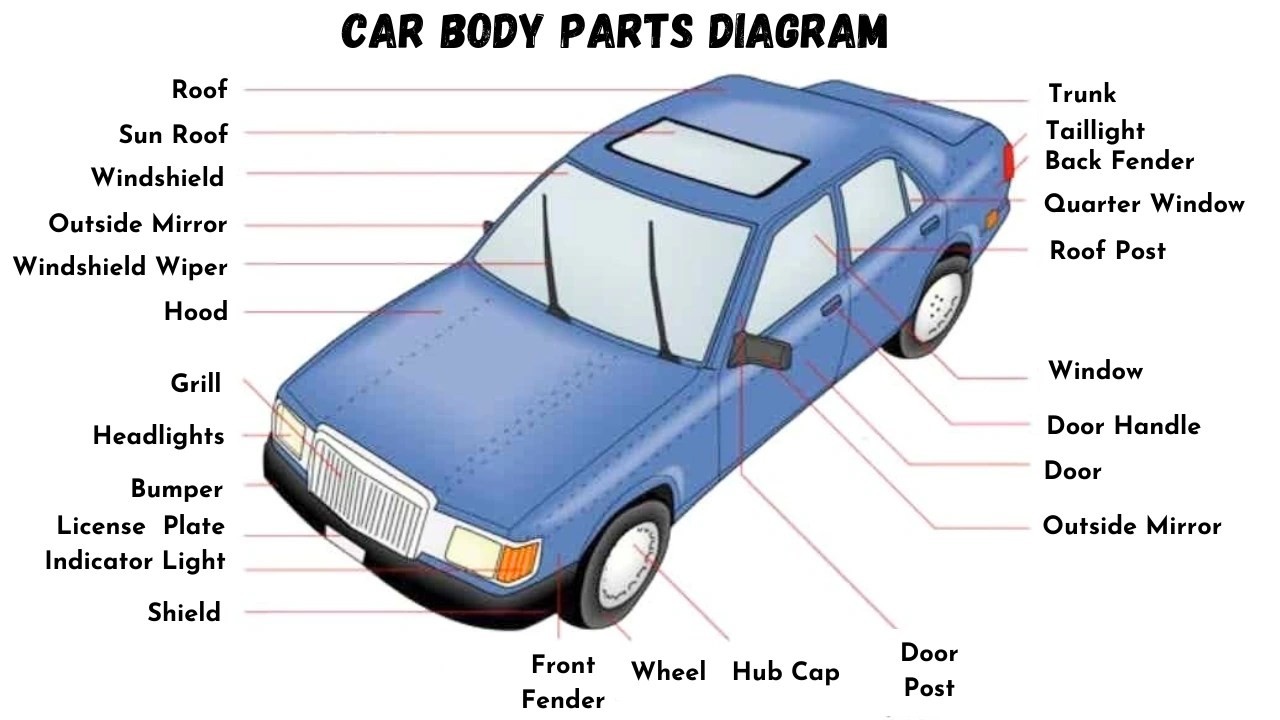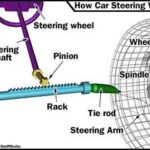Understanding the anatomy of a car can be fascinating and incredibly useful, whether you’re a seasoned mechanic or just a car owner wanting to know more. Just like the human body has a skeleton and vital organs, a car relies on a complex framework and various components to function. While the original article focused on car body parts, let’s dive deeper into the foundational elements, exploring the names and functions of crucial car chassis parts and related body components that are essential for any vehicle’s structure and performance.
The chassis is essentially the skeleton of your car, providing the structural support for all other components. While the term “chassis” technically refers to the frame and running gear, in common automotive discussions, it’s often used more broadly to include many of the structural elements beneath the car’s skin. This article will cover both aspects – the traditional chassis components and related body parts that contribute to the vehicle’s overall structure.
Key Car Chassis and Body Parts Explained
Here’s a breakdown of essential car chassis and body components. While some of these were mentioned in the original article primarily as body parts, we’ll explore them in the context of their structural role and connection to the chassis where applicable.
-
Body Shell: The foundational structure of the car’s body. Think of it as the main cabin and exterior shape, before doors, hood, and other panels are attached. The body shell provides the primary form and protection for occupants.
-
Chassis Frame (if applicable): In older or larger vehicles, particularly trucks and SUVs, you might find a separate chassis frame. This is a rigid structure underneath the body shell that provides the main support for the engine, transmission, suspension, and body. Modern passenger cars often use a unibody construction, where the chassis and body are integrated into a single structure, making the body shell itself a load-bearing part.
-
Subframes: Even in unibody cars, subframes are often used. These are smaller, modular frames attached to the main body shell. Subframes typically support the engine, transmission, and suspension components, helping to isolate vibrations and improve handling.
-
Pillars (A, B, C, D): These are the vertical support structures that hold up the car’s roof and provide structural rigidity.
- A-Pillar: The front pillar on either side of the windshield. Crucial for roof support and rollover protection.
- B-Pillar: Located between the front and rear doors on each side (in four-door cars). Significantly contributes to side impact safety and roof strength.
- C-Pillar: The rear pillar, behind the rear doors (or behind the only door in two-door cars). Helps form the rear of the passenger cabin and supports the roof.
- D-Pillar: Found in some larger vehicles like wagons and SUVs, located behind the C-pillar and before the rear window. Provides further roof support and structural integrity in longer vehicles.
-
Rails (Side Rails/Frame Rails): These are longitudinal structural members that run along the length of the vehicle, often forming part of the chassis or unibody structure. They provide crucial strength for resisting bending and twisting forces.
-
Crossmembers: These structural components run across the width of the vehicle, connecting the side rails or chassis frame rails. They enhance rigidity and help distribute loads across the chassis.
-
Floor Pan: The base of the car’s body, forming the floor of the passenger compartment and cargo area. It’s a crucial structural element that provides a platform for seats and other interior components, and contributes to overall body stiffness.
-
Firewall: A critical safety component separating the engine compartment from the passenger cabin. It’s designed to be fire-resistant and helps protect occupants from engine fires and heat. It also adds structural rigidity to the front of the vehicle.
-
Fenders (Wings): While often considered body panels, fenders are structurally significant as they enclose the wheel wells and are bolted to the body shell or subframe. They protect the car body from road debris thrown up by the tires and contribute to aerodynamics.
- Front Fender: Located at the front wheels.
- Rear Fender (Quarter Panel): Located at the rear wheels.
-
Hood (Bonnet): The hinged cover over the engine compartment. While primarily a body panel for access and aesthetics, it adds a degree of frontal structural integrity and aerodynamic efficiency.
-
Doors: Provide access to the vehicle’s interior and contribute to side impact safety. Car doors are complex structures with internal reinforcement beams for occupant protection.
-
Roof: The top panel of the car, providing protection from the elements and contributing to the vehicle’s overall structural rigidity, especially in rollover accidents.
-
Bumpers: Designed to absorb impact in low-speed collisions, protecting the chassis and body from damage. Modern bumpers are complex systems often incorporating energy-absorbing materials and sensors.
- Front Bumper: Protects the front of the vehicle.
- Rear Bumper: Protects the rear of the vehicle.
-
Cowl Panel: The area at the base of the windshield, often housing the windshield wipers and air intakes for the cabin ventilation system. It also provides structural support at the base of the windshield.
-
Radiator Support: A structural frame, typically at the front of the car, that supports the radiator, headlights, and grille. It’s often designed to crumple in a collision to absorb energy and protect the occupants.
 Car Body Parts Diagram
Car Body Parts Diagram
Deeper Dive into Chassis Components
While the above list includes body parts with structural relevance, let’s briefly touch upon parts more traditionally associated with the chassis, even though they weren’t the primary focus of the original article, to provide a more complete picture of the vehicle’s foundational structure:
-
Suspension System Mounts: Points on the chassis or subframe where the suspension components (like control arms, struts, and shocks) are attached. These mounts must be robust to handle the forces from the suspension.
-
Steering Rack Mounts: Securely hold the steering rack to the chassis, allowing for precise steering control.
-
Engine Mounts and Transmission Mounts: These dampen vibrations and securely attach the engine and transmission to the chassis or subframe.
-
Axle Mounts and Differential Mounts: In vehicles with rear-wheel drive or four-wheel drive, these mounts secure the axles and differential to the chassis.
Why Understanding Car Chassis Part Names Matters
Knowing the names of car chassis and body parts is more than just automotive trivia. It’s practical knowledge that can benefit you in several ways:
- Communication with Mechanics: Being able to accurately name parts ensures clear communication when describing issues or requesting repairs.
- DIY Car Maintenance: For those who enjoy working on their cars, knowing part names is essential for following repair manuals and ordering the correct components.
- Accident Assessment: In case of an accident, understanding which parts are damaged can help you assess the severity and communicate effectively with insurance companies and repair shops.
- General Car Knowledge: It enhances your overall understanding of how cars are built and function, making you a more informed car owner.
Conclusion
While the original article provided a good overview of car body parts, expanding our knowledge to include chassis components gives a more complete understanding of vehicle structure. The chassis and body parts work in concert to provide safety, performance, and functionality. By familiarizing yourself with these Car Chassis Part Names, you’re taking a significant step in becoming a more knowledgeable and engaged car enthusiast or owner. This understanding empowers you to better maintain, understand, and appreciate the complex machine that is your automobile.
